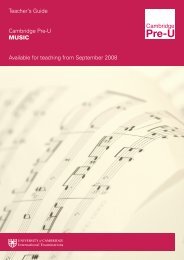Cambridge Pre-U Syllabus - Cambridge International Examinations
Cambridge Pre-U Syllabus - Cambridge International Examinations
Cambridge Pre-U Syllabus - Cambridge International Examinations
Create successful ePaper yourself
Turn your PDF publications into a flip-book with our unique Google optimized e-Paper software.
20<br />
1.5 Respiration<br />
Content<br />
ATP<br />
Chemiosmosis<br />
Glycolysis<br />
Anaerobic respiration<br />
Reactions within mitochondria<br />
Candidates should be able to:<br />
Learning outcomes<br />
<strong>Cambridge</strong> <strong>Pre</strong>-U Draft<br />
a) explain the need to release energy to drive metabolic reactions and the role of ATP<br />
b) outline chemiosmosis as a system in prokaryotes and eukaryotes in which:<br />
• electrons may gain energy from oxidation of chemical substrates and that this energy may be used<br />
to do work<br />
• energetic electrons pass through the electron transport system to release energy<br />
• the released energy is used to transfer protons out through membranes<br />
• as these protons diffuse back through the membrane, their kinetic energy is used in membraneassociated<br />
ATP synthase to add phosphate to ADP, forming ATP<br />
c) outline glycolysis (phosphorylation to fructose 1,6-bisphosphate, hydrolysis to triose phosphate,<br />
oxidation and dephosphorylation to pyruvate)<br />
d) outline the link reaction and Krebs cycle within the mitochondrion, general principles of dehydrogenation<br />
and decarboxylation to produce ATP, and reduced NAD and FAD<br />
e) outline anaerobic respiration in animals limited to the oxidation of reduced NAD to regenerate NAD and<br />
conversion of pyruvate to lactate and at the same level of detail, compare and contrast this with<br />
anaerobic respiration in yeast and plants<br />
f) compare and contrast the energy released per molecule of glucose substrate in aerobic and anaerobic<br />
conditions and explain the reasons for the difference<br />
Practical learning outcomes<br />
Candidates should be able to:<br />
i) investigate the rate of glucose respiration by yeast in aerobic and anaerobic conditions<br />
ii) investigate the effect of temperature on the rate of respiration using simple respirometers

















